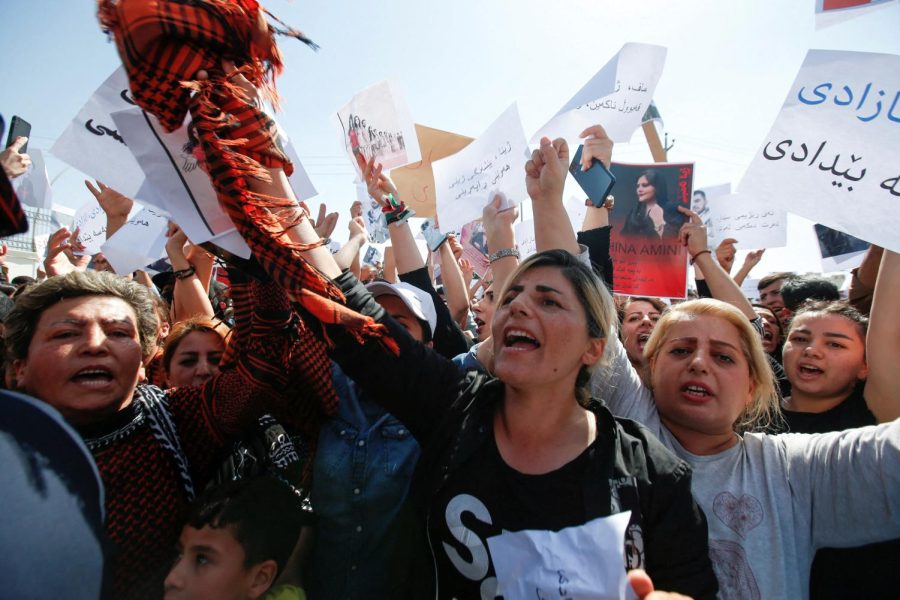Mahsa Amini deserves justice
The magnitude to which Amini’s death has been met with opposition is an inspiring sight to behold
The protests surrounding Mahsa Amini’s death show Iranian women’s resistance to oppression, writes Natasha Heisenberg.
October 6, 2022
During the last few days, the streets of over 40 cities in Iran have more closely resembled a battleground than a metropolis. Flooded with protestors, consumed by flames and reverberating with chants, chaos has enveloped the country. The conflict on these streets, however, is not war, but rather a retaliation against the oppression of women that has erupted following the murder of Mahsa Amini.
On Friday, Sept. 23, Amini was arrested by the Iranian “morality police” for breaking the country’s hijab law. She died later that day after suffering blunt trauma to her head. Iranian officials claimed that Amini’s death resulted from a heart at- tack, yet multiple eyewitnesses have disputed this, saying she was beaten in the police van upon her arrest.
Amini’s family has joined the chorus of voices calling for justice after news of her attack circulated through Iran. Her parents, who commented on the atrocity publicly, labeled it torture, further stoking the fire of unrest already unfolding in the streets.
Amini’s death is merely the tip of the iceberg in what has been an attack on women’s autonomy since the 1979 Iranian Revolution. Fundamental human rights, such as the ability to receive an education, gain equal opportunities in marriage and protection against violence have been dismantled, among many other measures seeking to reinforce the patriarchal and traditional Islamic values of the regime.
In the four decades between the Iranian Revolution and the present day, protests have taken place specifically regarding forced veiling and hijab mandates. Despite gaining momentum and garnering the support of women across the country, these demonstrations have done very little to alter the government’s attitude towards “improper” dress.
In 2019, protests ravaged the nation in what was known as Bloody November, calling for a new Iranian democracy. This movement became the most violent uprising since the Revolution, and resulted in greater government restrictions on personal freedoms.
Ebrahim Raisi, Iran’s extremist president elected in 2021, has maintained the oppressive ideals present in the country surrounding the practice of veiling. Raisi has additionally strengthened government response to breaches of this practice by seeking out and jailing individuals found in violation of these laws. For many, including Amini, this has cost them the ultimate price.
The magnitude to which Amini’s death has been met with opposition is an inspiring sight to behold, particularly in a country where the stakes for engaging in acts of defiance are high. As women across the nation publicly remove their hijabs and cut their hair, those from all around the globe have turned to watch. However, the response from the Iranian government indicates that the struggle is far from over.
The ongoing demonstrations have caused Iranian authorities to restrict internet access throughout the nation until the protests cease. While the conflict escalates, and the death toll continues to rise in the dozens, it is unsure when that date will
beTh. e international attention directed towards Iran over the course of the last week has demonstrated the power of social media in times of oppression and uprising. Fueling action through the sharing of photos, videos and information, the movement has spread from Tehran to cities possessing even more traditional Islamic values, such as the city of Mashhad.
Iranian authorities have begun attempting to identify protestors from photos and videos disseminating across the internet in order to enforce punitive measures. Authorities have also threatened to counter-protestors with the Iranian Revolutionary Guard Corps and the army. In streets already ablaze with conflict, this warning looms large as the demonstrations become increasingly more dangerous to attend.
While the protests have shown an outpouring of female support, men have joined the ranks, too. As the days drag on and outrage is amplified, men have taken to the streets to express their fury alongside the women of the country. Their presence does not go unnoticed, especially during such a critical point in Iran’s reckoning with the historic patriarchal systems at play.
There is hope, however slim, that these protests could rally the country, resulting in an upheaval of the current political rulers. Though the likelihood that this movement has the potential to overthrow the extremist leaders holding power is small, the passion and resilience shown by protesters has been encouraging.
Women in Iran are tired of living under decades of oppression. As protesters symbolically cast stones at portraits of Ayatollah Ali Kahmenei, reminiscent of centuries of heinous stoning committed against women, they are demanding an end to the radical values inherent to the regime.
Only time will tell if Iran can gather the support necessary to elicit the action they wish to see. For now, the world will continue to watch, with the hope that after years of brutality and injustice against women, Iran can have a chance at equality.















